#hinduism outside India
Photo
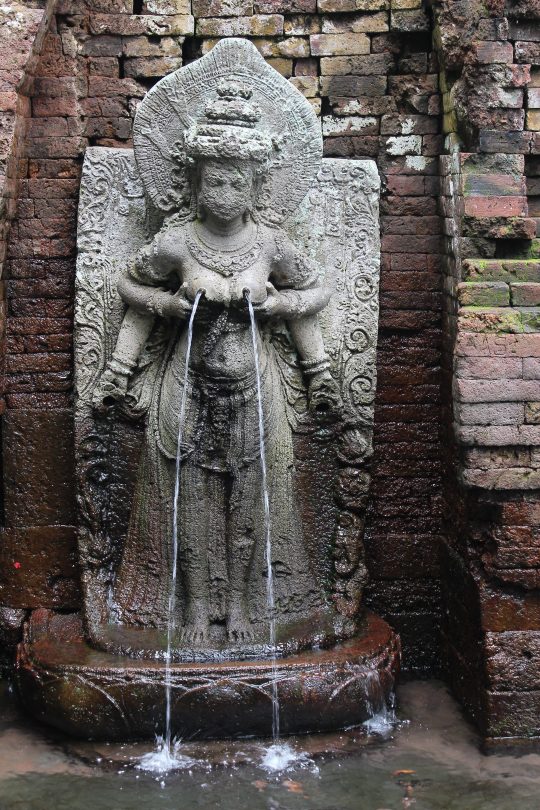
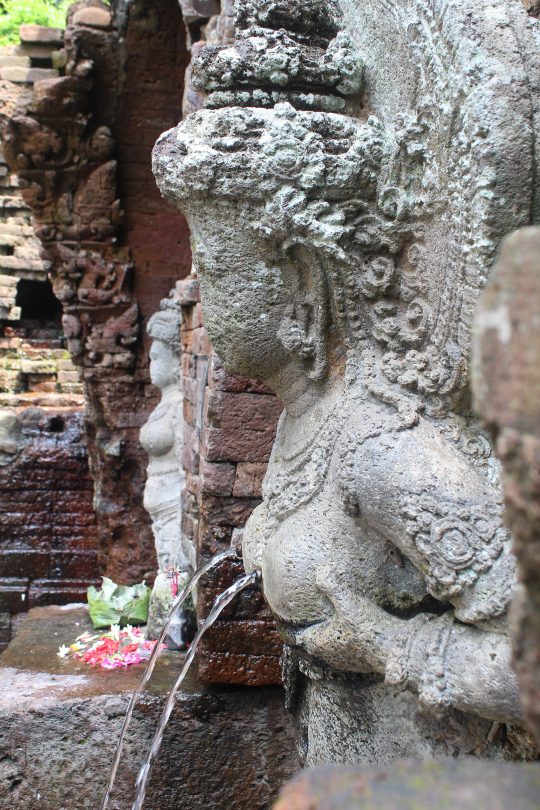
Lakshmi fountain, Candi Belahan, Java
4K notes
·
View notes
Text
the way sanghis will cry hinduphobia at any criticism of the indian government but have nothing to say commodification and bastardization of hinduism and hindu spiritualism in the west. like you guys only bring up hinduphobia to suck narendra modi’s toes and silence anyone who doesn’t agree with you.
#exposing myself as an nri with this one. sorry everyone#but the way hindutvas only bring up hinduphobia to justify their own bigotry#and not examine any of their biases.#like even now if they suddenly start caring about cultural appropriation#they won’t outside of their own agenda. it’s just gonna fuel the victim complex#sigh. i’m tired#anti hindutva#desi tag#desiblr#hinduism#india
7 notes
·
View notes
Text
another weirdly sentimental interesting passage from early Naipaul is this bit he has—-the Hindus in Trinidad, with a long history, had adapted their own traditions, one of which was the declaration that a local river *was* the equivalent of Ganga, and so they did all the rites there. One thing I value in early Naipaul is that he’s not a romantic: the preservation of Brahminism is a part of this.
But after India’s independence, with greater trade, suddenly Hindus in Trinidad simply give it up, over night, centuries of history and practice—-why? Well, the real Ganga is in India, and you can import the water now.
#this is how naipaul puts it anyway#the utter centrality of India as a nation to the concept of Hinduism isn’t talked about much#if you’re outside that you either aspire to it or you go to hell. simple as
22 notes
·
View notes
Note
im asking this out of pure ignorance but I've always wondered how does hinduism handle people who are not hindu? i know Christianity is essentially 'be the right kind of christian or go to hell' (so much as to beleive that Jewish people are literally devils, for example) but i was wondering how hinduism deals w people who are in proximity but not of the same religion. also if a dalit or lower caste person converts from hinduism to another religion, how does that affect thier life and how they're treated? appreciate your answer if u feel like explaining ^__^
it depends, in some parts of the country the non hindu has the same status as the lower caste dalit by default – so exclusion but in most places its a detente where religious and caste endogamy is strictly maintained. housing and employment discrimination is v common. its actually much harder to marry under the special mariage act and violence against interfaith and intercaste couples by their own families is common. in 2023, the muslim is the designated enemy of the state. the christian was fooled by the british and/or money to give up their culture or is literally a foreign agent. if you're looking for a textual answer, the equivalent of the "infidel," there isn’t really one because the streamlining of the canonical religious texts and construction of the hindu is recent. hinduism has aimed to appropriate instead of convert.
in modern india, legally anyone who is not a christian or a muslim is treated as a hindu. you are hindu by default in india to the state, governed by hindu codes for marriage and inheritance. for indigenous tribals it is a matter of coercing their children to feel shame at the (state sponsored but outsourced to private religious groups, love privatisation!!!) residential schools about their animist practices and making them worship the proper gods. for sikhs, jains and buddhists their is marginally more toleration. but they are basically seen as wayward hindu sects. this does change when they're in conflict with the majority in a way that resists "national cohesion" – see sikh pogroms in 1984 and the recent moves against sikhism due to the invocation of khalistan in the farmers protests. when dalits convert to buddhism many right wingers will invoke the spectre of predatory conversions.
since you are supposed to be hindu by default, christians and muslims are then seen as invasive outsiders and conversions are regulated very strictly by many states. it is historically true that christian missionaries brought christianity as part of a broader civilising mission, but imo it says something really depressing about hinduism that its epithets for christians is 'ricebag converts' bc people apparently converted for a bag of rice. islam's foothold in the continent is older, accompanying immigration from the west as well as the sultanate and the mughals. returning these christians and muslims to the fold, or "ghar wapsi" is a major project of the hindutva right. note that india is home to one of the world's largest populations of muslims (~200mil).
lower caste dalits have long converted to christianity and islam but caste violence follows them there anyway. caste may have textual origins in religion and focus on ritual purity but it is a socioeconomic form of subjugation. this means that while still subject to caste violence, dalit christians and muslims will be denied redressal through state protections like legislations against anti caste violence or reservations because those are restricted to hindu dalits.
334 notes
·
View notes
Text
If speaking for decolonisation of Hindu temples in India and Hindu cultural renaissance, as well as the welfare of the Jews as they face anti-semitism in every other post I see, is fascist and zionist to you, block me. If the revival of Ram mandir is a matter of mourning and shame because the Babri was deconstructed in the process as it did not have any right to stand there by demolishing the place of worship of the Hindus, do not ever contact me again. I'm not the person you're gonna like and imma tell you one more thing - I have no more fucks to give. You take our land, you give it back. The janmabhoomi cannot be shifted but the mosque could and it has, my dude. So will the Gyanvapi and Shahi Eidgah of Kashi and Mathura respectively, because they were seized from us. Because they belong to our Shiva and Keshava and nobody has the right to tell us otherwise. If speaking against Mughal holocausts and genocides against Hindus offends you in any way and leads you into believing that I'm spreading communal hatred because you have by far assumed that I'm Islamophobic, and that Hinduphobia does not exist in and outside India, go no contact with me. Yeah that's it for now. I might edit this post later as I remember more pseudo-liberal agenda and protests against the Rama temple despite the supreme court favouring it in all ways. Despite all these evidences many of you say that it could have been a hospital or school because hey, we can trash on Hinduism all we like. The place isn't anything else because Parasaran sir said - "Once a temple, always a temple." Suggest all those things for the land granted for the other place of worship, if you dare. Wouldn't say that it's genius or even remotely decent either but do go ahead, y'all like to teach us stuff more than anything else. All this Hinduphobia I see here, fills me with more adrenaline to sprinkle salt on your cuts and burns. Have a good time my lovelies.
#hinduism#hinduphobia#hindutva#sanatana dharma#we are and shall be endless for a reason#this is a question of our identity
72 notes
·
View notes
Text

I accidentally deleted this ask yesterday but fortunately had a screenshot. Ngl I'm kind of ??? about it because...why would you single out Hinduism to pick the most fundamentalist, cultural and political aspect of it, that's not even practised in most the Hindu minorities outside of India? Nearly every community in India has a caste system regardless of religion. Within Hinduism there's no just one caste system either. Eelam Tamil Hindus have a caste system, but it's not as violent as India's (although of course still violent and oppressive). Sinhalese have a caste system too, and the ones still invested in it would swear blind this was related to Buddhism somehow, a doctrine that preaches against inequality of any kind. Caste systems are literally haram in Islam and yet some Muslim communities managed to rationalize creating one because they wanted to assimilate into the worst of us I guess.
I know fuck all about Hinduism to tell you the truth, but my sister is a convert and devotee of Durga Matha. I asked her about it and she sent me this:
There are as many variants of Hinduism as there are varieties of grass. The only thing they have in common is the Vedas which is a bunch of hymns and stuff. It doesn't really go into detail about caste.
The caste system comes from a book called Manu Smriti. Some accept it as a Hindu text, some don't. Hinduism isn't even a religion actually. It's a bunch of similar belief systems that the Britishers lumped in together for ease of classification. Within Hinduism there are many sects- Saivism, Shaktism, Vaishnavism, etc. So to define Hinduism as some sort of oppressive religion doesn't make sense because it isn't a religion as Westerners define it. Anyway, truth is everyone cherry picks the parts of religion that suits them and discards the rest. Some think that's being dishonest. I think that's just common sense.
This makes sense to me. It's very colonial to monolithize belief systems that evolved from the disparate religious texts and syncretic practices of dozens of kingdoms and dynasties over 4000 years, just because it shares the unique character of belonging to the Indian subcontinent. (Which is precisely why its propagated by Hindutva nutcases. They're imperialist colonizers permanently snorting Indian manifest destiny crack.)
Bestie. Friendo. My guy (gender neutral). Ideology doesn't shape society. People wrap ideology around what they already want to believe and do. This is how you get Zionists (both Christian and Jewish), Wahabi/Salafi Muslims, Hindutvas and... whatever we're supposed to call this current iteration of Theravadin Buddhism that is also characterized by ethnosupremacy and genocide. Religion takes the character of the individuals and ideologues that choose to follow it. There are no exceptions.
To reiterate the point that inspired this ask: Some LGBT folks's queerness is inextricable from their religious identity. Stigmatising and ostracizing religion in queer spaces is alienating, racist and violent. Just like no one should force religion on you, no one should force secularism on people either. There is enough air for us all to breathe free.
#religion#hinduism#religious tolerance#casteism#social stratification#buddhism#islam#anti zionism#hindutva#culture and society#racism#colonialism#christianity#knee of huss#asks#anon#sri lanka
54 notes
·
View notes
Text
marigolds

It's October! For half the hemisphere, the nights are getting longer, the wind is getting colder and the weather is taking on a distinct grey and overcast mood. What better time than now to steal a few last bursts of brilliant, warm sunshine and keep them close against the coming of winter?
Enter October's flower (one of them) - the marigold.
An interesting thing I found while researching this month's flower was that its native to the Americas - and yet some sites list the ancient Greeks and Romans having traditions surrounding the marigold. One of the sites even mentions the flower being introduced to the 'Americas' several sentences after telling me its native to Mexico. I think some of the confusion may come from the fact that there are marigolds of the Tagetes genus, which are the ones I think of when I think of marigolds, that were first mentioned by the Aztecs and are native to the Americas - and there is a flower, Calendula officinalis, called the 'pot marigold' which comes from the same daisy family but is a different genus and seems to originate in southern Europe. To add to the confusion, the Spanish imported the Tagetes marigold from the Americas and from Spain it spread to, particularly, monastery gardens across Europe where it was cultivated into various strains with names like the African or French marigold. The American marigold didn't even have an official genus name until 1753. So, sorting through marigold myths was a lot like playing 'guess which twin it is' for me especially since the majority of the sites I was wandering through either weren't aware of a difference or didn't differentiate. I found one site that marked the difference between them (shout out to growingvale.com). I can understand why. We're only talking flower folklore here, not nuclear codes. My little nitpicky soul though just wasn't happy until it figured out what was going on. I am now going to spew facts at you and try to tell you which flower is which for each of them.
We'll see how I do.
Let's start at the beginning.
Tagetes marigolds were first recorded as being cultivated by the Aztecs, who considered them both medicinal and sacred. That tradition has carried over into Mexico's el Día de los Muertos, the Day of the Dead, which is celebrated either in late October or Early November depending on the region. How much of that is straight from the Aztecs and how much is later European influence via Catholicism is still up for debate but the marigold plays a special part in both. The brightness and strong scent of the marigold flowers are believed to help guide the spirits of the dead to their family and to the offerings left out for them. You watched Disney's Coco (or Fox's The Book of Life), you get it. The Day of the Dead is celebrated outside of Mexico as well, with traditions varying from place to place but right now, we're talking marigolds.
In a half step to the side of that, the Victorians also considered marigolds a funeral flower but in a solemn and grief-filled way that made their cheery color inappropriate for any other kind of bouquet.
In South Asia, the Tagetes marigold has in large part replaced Calendula officinalis marigold while still serving the same purpose. There marigolds are used to create garlands and decorations for weddings, festivals and sacred holidays. Both Buddhism and Hinduism attach spiritual significance to the flowers. In India, giving a garland of marigolds to someone is considered a sign of friendship.
Walking it back to our Calendula officinalis marigold, the common name of 'marigold' is actually a break down of 'Mary's gold'. The golden colored plant was often left on alters and shrines to the Virgin Mary in Catholic countries in the middle ages by people that couldn't afford to leave actual coins. Its bright sunshine color and availability to everyone soon became associated with her.
This is the marigold that the ancient Romans and Greeks used medicinally and that medieval Europe thought was a cure against the plague. This is also the marigold that was woven into garlands for doors and livestock in Ireland to keep away fairy attention.
Both branches of flowers are popular with love superstitions, representing never having to lose a love and as a good luck charm when it comes to love.
And let's round things off with a gardening fact. Marigold are considered excellent companion plants for most vegetable gardens because they repel pests from the big to the very tiny kind. Just check before you plant. Their roots also give off an antibacterial chemical that will wreck havoc on your legumes.
Happy birthday, October babies!

#marigold#marigolds#folklore#superstition#cottagecore#herbalism#herbology#october#birth flower#day of the dead#dia de los muertos#dia de muertos#right up there with#dandelions#as a sunshine flower#flowers#language of flowers#meaning of flowers
58 notes
·
View notes
Note
I'm from the USA and took a lot of Indian history courses at my university. You might already know this or have guessed it, but a lot of what we learned was taught from a leftist--and at times explicitly Marxist--perspective. This was even stronger in other (but thankfully not all!) social studies departments where there were classes focusing solely on various social ills of Hinduism with regard to caste and issues of feminism, yet almost nothing negative could be said if it might be critical of Islam or Muslim figures, (Mahmud of Ghazni being a notable exception for one of my professors.) There was a whole class on British colonialism; no details were spared. Horrible famines in the Deccan, Odisha, Bengal. The decimation of the textile industry. Banning bharatanatyam. The salt tax. Accounts of how a British man kicked one of his servants to death, and another of how the poor and sick congregated outside the gates of a hospital in the south that at the time would only help Europeans. Jallianwala Bagh. But Aurangzeb? Completely whitewashed. You would think Sikhs carry a kirpan for no reason. It was only through reading additional books and documents for my essays and projects that I learned about how he tore down temples, smashed murtis (and stole valuable ones,) levied a double tax on non-Muslims, etc. I remember reading an account of a traveler going through the south at the time of the Deccan wars, remarking on how you could find entire villages empty and deserted fields full of unharvested crops because the people had fled advancing armies. In one region his forces simply killed some Telugu-speaking Brahmins serving the local king rather than force them to convert, and in another his forces captured a royal scribe, forced him to convert to Islam, and forcibly circumcized him before the man killed himself. Obviously the history of all things under the umbrella of Hinduism or any other system is not perfect, but there was a huge difference in how critical you could be of Hinduism (and even western traditions/ideas) compared to Islam.
Sometimes I daydream about what it would have been like to study Sangam literature in India or to experience Andal without needing an English translation, or going to translate old Sanskrit copies of the Mahabharata whose telling is unique to a certain village or something. But ultimately I'm glad I chose to be a research scientist instead and have a career in that, because I don't think I would have been able to succeed in academia unless I were a leftist. :\ Honestly I feel like even going to hang out with ISKCON for a few days would be a better introduction to Hinduism for the average person abroad with zero knowledge than a class called "Intersections of Gender and Caste in Hinduism" or something.
Very telling how Hinduism, and even Christianity is ripped apart in academia, yet when it comes to Islam, it is a religion of "tolerance, and beauty that respects women."
Honestly, though, it's because of how severely they react when their religion is criticized or even inspected. Apostates are given death, women who do not obey are given death, anyone who utters a word against their precious prophets is given, you guessed it! Death.
No religion is perfect, humans can be horrific creatures, and even Hinduism cannot escape that. But Islam has committed far more war crimes than any other religion.
It absolutely boils my blood to see traces of colonizers in our cities. One side of my family hails from Aurangabad, named aftre Aurangzeb, and you already know the atrocities he committed.
It's so fucking insidious to see how the youth have been told what to think. My own friend claimed to me, verbatim: "You cannot be neutral in the Israel-Palestine war. Either you support Palestine, or you support genocide."
Support Hamas? Support terrorism? The same terrorism that affects us? Has everyone forgotten 26/11?
It makes me so sad to think of the future we could have had. Sanskrit would be the most spoken language, instead of English. Gurukuls would exist, and India would still have all of its wealth.
You're right, even ISKCON is better than the propaganda they feed people about our religion.
#anon asks#answered#hinduphobia#anon i'm glad you didnt get brainwashed thats the silver lining at least#hindublr
34 notes
·
View notes
Text
Notes on Anitismo - The Ancient Religion of the Philippines by Isabelo de los Reyes.

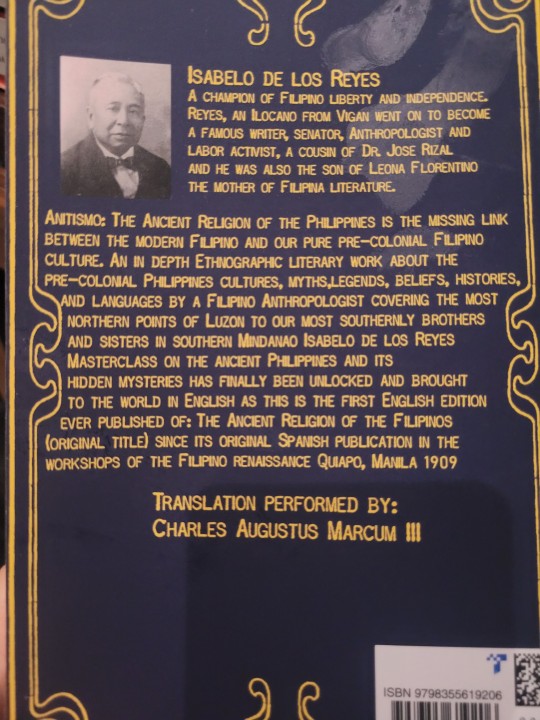
Keep in mind - this was written a while back.
Ancient Chronicles written by the Jesuit hispanic Friars state that at the that the first spaniards set foot in the Philippines from the coast of visayas to Manila there was a considerable population of Muslim converts
This was especially true for Mindanao due to conversion by Islamic teachers from Borneo
De los Reyes argues that because of this, to find native Filipino religion at its purest, we must look to the North
Distinguishing native religion without outside influence such as from Islam, Hinduism, Christianity etc can be tricky
However he argues that the traces of Native Filipino religion can be found in the stories superstitions and advice that belong to various Filipino ethnic groups (Tagalogs, Bicolanos, Zambalenos etc)
From the South of the country in Mindanao to the extreme North like Luzon, De los Reyes argues then native Filipino religion was consistent
This religion was Anitism or the Cult of Anito, meaning souls of the ancestors.
Anitism is not a monolithic religion and hosts a broad pantheon ranging from Gods to animals, nature, elements and space.
The Philippines had its own modern spiritism and De los Reyes argues this may have been the origins of the cults of "Romanist Saints" (Catholic saints) in the Philippines. By this I think he means that Filipino spirituality influenced how Filipinos proceeded with Catholic worship.
The oldest chronicles about the Philippines can be found in various museums and libraries (such as the National Library of Madrid, Covenant of St Augustine in Manila)
We can follow these chronicles, from when the Jesuit Pedro Quirino provided news of religion in the Philippines in 1604, followed by reproductions by others like the Jesuit Colin in 1663 and others such as Fr. Morga, Gonzalez de Mendoza, Aduarte etc.
Fr Morga said that Filipinos practised Anitism in certain regions like Camarines and Cagayan.
Some traditions would say that Manila and its regions were not originally native to the island - they were from Malayan islands and other remote areas.
Before the Spaniards arrived, Islamic teachers from Borneo came to preach and interacted with the locals
Their teachings and beliefs spread quickly throughout the Philippines
Fr. Grijalva writes that they (Filipinos) started adopting their traditions and took on their names.
De Los Reyes argues that Spanish conquistadors' arrival/conquest was delayed because Filipinos were already familiar with various religions and beliefs and also because of the hands of Datu Lapu Lapu. What I believe he is arguing is that Datu Lapu Lapu and the previous exposure Filipinos had to different religions at first delayed Spanish influence from spreading so quickly.
Other islanders who weren't under the control of the government in the Philippines has their beliefs influenced by religious preachers who travelled to them from the Straits of Malacca and the Red Sea.
An account, dated April 20th 1572 (preserved in the archives of India) which is from the conquest of Luzon details "In these towns, closest to the sea, they do not eat any pork, which the moors taught them. But if you ask them, they say they do not know Muhammed or his law." This account was reproduced by Wenceslao Retana.
In actuality, very few Filipinos could understand/read the teachings of the Koran despite the Islamic influence.
In Filipino traditions, reverence and worship was given to nature and the elements, and this was usually consistent throughout the islands.
Native Filipino religion beliefs include elements, animals, stars and ancestors.
Filipino religion in Manila and nearby areas was a mixture or Anitism, Buddhism, Hinduism and Islam brought by the Malays of Borneo.
Vocabulary included Sanskrit and Malay terms such as Bathala, meaning Lord.
However these terms are not used in Northern provinces.
De Los Reyes argues that Itnegs and other mountain tribes conserved and maintained the purest form of Filipino religion
In the Ilocos, Cagayan, Isabela and other provinces of Northern Luzon, native Filipino religion was more prevalent
Hindus and Buddhists converted many in Java and Malaysia.
However Muslim influence became dominant in 1478 - 60 years before the Dutch invasion.
According to Javanese legends, Hindus arrives in Java 78 years before Christ.
The first Malays came from the Minangkabau river region to establish cities in Malacca , Ojohor and Singapore in the 12th century, as per Malacca records.
In the 13th, 14th and 15th centuries, there were various Malaysian emigrations reaching the Philippines
De Los Reyes argues that Filipinos may have also populated the islands of Malaysia, and emigrations could have originated from strong winds coming down from the North.
The first Spaniards found the son of Lakandula, King of Manila, when they went to Borneo.
The emperor's master of ceremonies from Japan (Mr Fujita) argued that emigration likely came from the north and that Filipinos may have some relations to the Japanese.
According to Geographers and Historians of the Mariana Islands, what De Los Reyes calls the "know it all Spanish" - had no idea about interesting ruins found in Oceania, one of which was a prehistoric statue that was being held in the British museum.
He argues there may be hidden megaliths, artefacts, and remnants of lost civilisation in the Philippines, as seen in various locations such as : Butacan caves, Pangibalon Hill, Madias de Iloilo and Nasso.
#Philippines#pre colonial philippines#Filipino#Filipino history#Anitism#Filipino religion#Pinoy#Isabelo de los Reyes#History#Asia#Asian history#South east Asian history#Religion#ancient religion#South east asia#Colonialism#spanish colonial#Spanish colonialism#Philippines history#Philippine history#Anitismo#Keep in mind this was written a while ago so some terms may be outdated#I've tried to interpret some tricky parts the best I could#My ass who is from the Northern Philippines 🗿
51 notes
·
View notes
Photo

Balinese mask
294 notes
·
View notes
Note
I want to agree with some of the things you said to the last anon there - 'Hinduism' sometimes feels like a combination of many different local religions and varies enormously from region to region and person to person. Some people absolutely believe in and worship multiple gods, some people believe in multiple gods but worship one god (for e.g. shaivaites, vaishnavites), some people lean into the spirituality of it all and believe in Brahman, and there are Hindu atheists as well. Obviously a massive disclaimer that I'm not any sort of expert or scholar but just a person who lives in India, so this has just been my observation.
I love the analytical posts about world religions and the lore for the MO-verse religions! I am way behind on MO but I will catch up when work eases up soon :)
Hi! Thanks for the comment, it is helpful to hear from someone on the soil, so to speak.
I have lots of theories about the ways in which Judaism is misunderstood by outside culture mirroring how Hinduism is misunderstood by outside culture. One day, maybe I'll go on a quest and then write a book about it.
#hinduism#theology#theology is complicated#hinduism as a catch-all term for indigenous religion in India
45 notes
·
View notes
Text

30 January 1948: Gandhi is assassinated on his way to prayer
A Hindu nationalist gunman believed the leader had betrayed his people
The clock had ticked past 5pm on 30 January 1948, and in the garden at Birla House, New Delhi, Mohandas Gandhi was running late. At the age of 78, the leader of India’s independence struggle still played a prominent role in the politics of the subcontinent, and had only recently completed a fast in protest at the violence between Hindus and Muslims. Now, the day’s business concluded, he and his great-nieces were on their way to a prayer meeting.
Outside, a crowd of several hundred schoolchildren, businessmen, holy men and even street-sellers was waiting. As Gandhi approached, one man pushed his way to the front. “Bapu [Father] is already 10 minutes late, why do you embarrass him?” asked Gandhi’s great-niece, Manuben. At that, the man pushed her aside, so that she dropped the rosary and notebook she was carrying. Then he levelled his Beretta pistol, and fired.
Whether Gandhi died on the spot remains controversial: some accounts say he breathed his last a few minutes later, after he had been carried inside. Either way, the shots were fatal. His assassin, who was seized immediately, turned out to be 39-year-old Nathuram Godse, a Hindu nationalist who believed that Gandhi had betrayed his people to the Muslims. “I sat brooding intensely on the atrocities perpetrated on Hinduism, and its dark and deadly future if left to face Islam outside and Gandhi inside,” he later told the court, “and… I decided all of a sudden to take the extreme step against Gandhi.” Godse was executed for his actions. But to some Hindu nationalists, he remains a martyr.
Daily inspiration. Discover more photos at Just for Books…?
10 notes
·
View notes
Note
check this bullshit out lmao

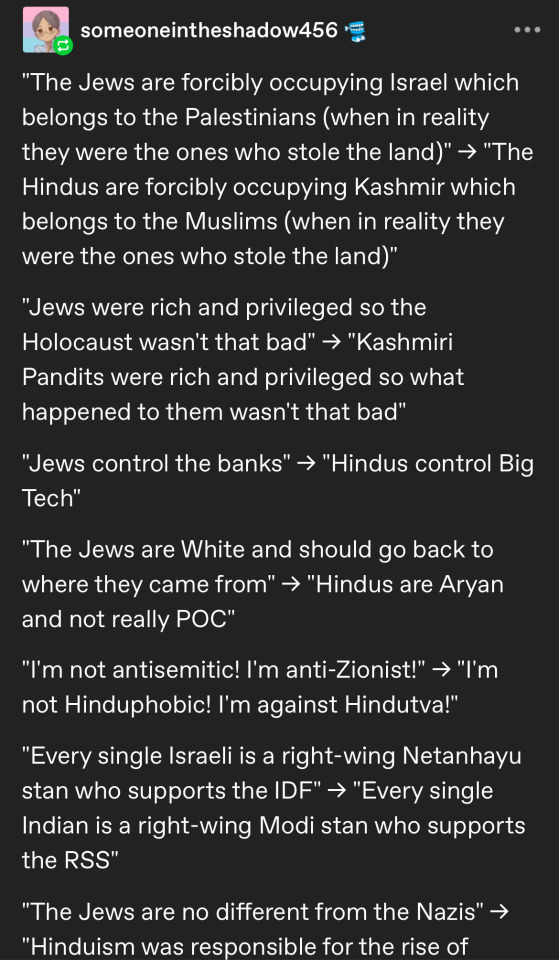

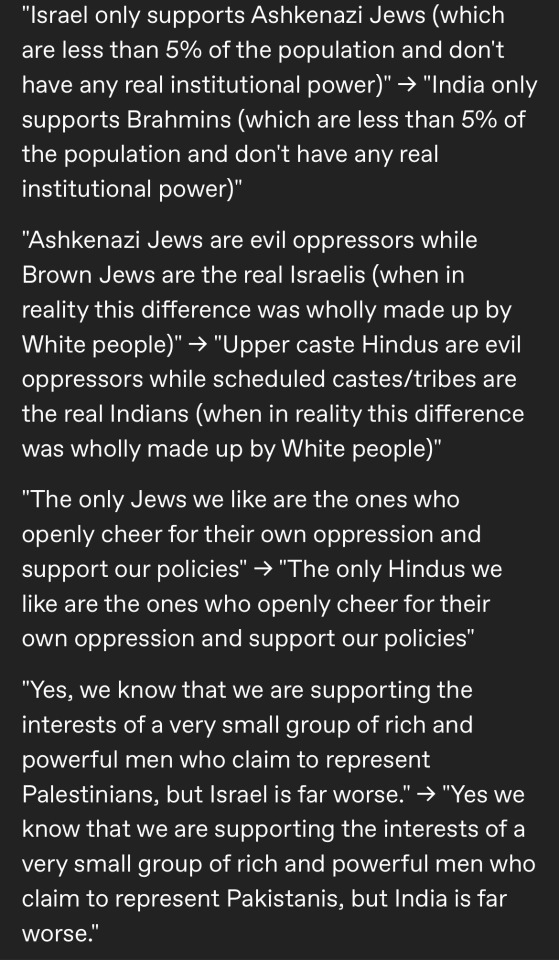

You guys are bringing me like rotten food, like im a baby vulture or something.
I love how India is not forcibly occupying Kashmir bc its perfectly normal to switch off the internet for years and arrest all democratically elected leaders and dissolve parliament when you're not an ovcupying force. I've never seen anyone claim Hinduism is responsible for the rise of Nazism, only point to how much Savarkar admired Hitler and Mussolini and its a pity that Jewish folk are seeing solidarity with a Hindutva movement that is fundamentally unconcerned about that. Do they know the RSS apes Nazi salutes and aesthetics?
I do love the Brahmins don't have any institutional power line and the upper caste/lower caste division is made up by white people stuff, bc it is the most blatant way to be sure this person has no real familiarity with Indian culture or history outside of like propaganda, because like, all Hindu texts enshrine the moral, legal and cultural superiority of Brahminism. Why does Eklavya the archer have this thumb cut off for daring to study archery in the Mahabharata? What does it mean that lower caste children cannot drink or eat at the same tables as upper caste children even in India's best universities exactly? Anti semitism has real roots in the history of Western civilization, from ghettos to the holocaust, permitting its association with the made up logic of Hinduphobia – which doesn't exist in India and outside of India is just plain racism is terrible. Upper caste supremacy is the bread and butter and organizing principle of Indian society for centuries, Hindutva politics dominates every single cultural sphere in India.
I also like that the Israel/Palestine is cast into India/Pakistan despite the fact Pakistan is a soverign nuclear armed state that is rapidly destabilizing at the moment due to US influence that India has very little to do with it. Most Pakistanis are also unaffected by India, in that India does not actually occupy Pakistan and enforce apartheid on its citizens despite right wing fantasies. Pakistan and India gets in standoffs with each other! The most significant amount of Kashmiri organising is for Azad Kashmir. Pakistan occupied Kashmir deserves to be free too.
61 notes
·
View notes
Note
Do you have any other Desi Johnny hc’s? I love them soo much, It’s so interesting to hear about other cultures! 🫶🏻
yea sure of course!!!
unfortunately still dont have many hcs so some of these will just b building off of old hcs but WHATEVERRRR
•ik i said he wears a lungi at like his house, but he actually did wear it from time to time in the curtis house for when he was sleeping over
•his spice intake is crazy he can eat something rlly spice w no reaction meanwhile everyone else is dying
•ik holi is a hindu holiday and hes not hindus BUT i think he would find it very pretty and be very interested in it (i mean shit unless u wanna hc his religion being hinduism be my guest)
•johnny actually uses a shawl a LOT when hes cold and when he notices that ponys cold he just, uses his cloth and makes pony wear a shawl too, literally 0 questions asked
•his fav food is biryani i will not be elaborating
•he eats w his hands a lot (like yknow he eats things like rice w his hands) he finds it pretty practical, and he WAS nervous about doing it around everyone else outside his home but he kinda grew out of that
•his mom used to feed him w her hands, thats like one of the better memories he has w her, so maybe???he also feeds pony w his hands??? as like a familial thing
•FUN FACT in 1952 there was this big emphasis on bengali culture, especially language and since johnny was born in like 1949, i think his mom (i hc him as half mexican half bengali, his mom is bengali, or if u want u can reverse it it truly does not matter) would have this big idea to surround him around him speaking bengali as his first language (if ur curious spanish is his second language, then english is his third)
•him learning english as his third language is kinda why he has trouble reading acc, i forgot if that was canon or not, but yea, he can speak it perfectly fine, he just didnt practice actually reading it as much
•he sees his mom as like bollywood pretty when she was younger, if that makes any sense, like movie star pretty (YES IK BOLLYWOOD IS FROM INDIA but my point still stands)
THATS THE HCS I GOT FOR NOW, if i messed anything up or wasnt culturally right someone feel free to tell me
7 notes
·
View notes
Text
Senju's Family Crest: Deeper meaning

金剛杵kongousho/vajra, an important buddhist symbol. 金剛 is hardest material, diamond, indestructible.
Indra, his rivals, Asura, and his weapon Vajra
Indra/Asura/Vajra are a bit different in Hinduism vs jp, mainly esoteric, Buddhism... So i want to learn, write, discuss.
Obviously, Religions, esp Hinduism, very diverse(diff groups/sects/regions say diff things, across diff time periods), this is general/simplified idea. if want correct/add.
Hinduism
Indra, said to be "title", rather than "name", king of Svarga, king of devas, associated with rain/storms. Known to wield Vajra, unstoppable, indestructible thunderbolt to vanquish evil spirits/sinners. A legend says that Indra has 1000 eyes, which used to be ?????? which he was cursed with due to his lust for women.
A legend says that Indra's Vajra originated a spinal column of Sage Dhadhichi, bones blessed by Lord Shiva earlier, who offered it, sacrificing himself, to help Indra defeat a powerful asura, Vritra.
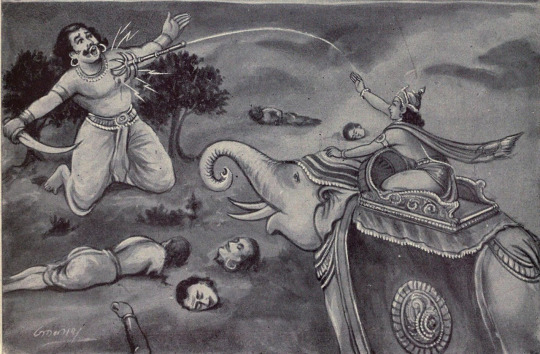
Devas are rivals of Asuras, which are sometimes demonlike, power hungry, associated with drought/famine. Indra killing Vritra symbolizes drought/rain cycle.

Param Vir Chakra, designed by Savitribai Khanolkar, India's highest military medal has Indra's Vajra, symbolizing Sage Dhadhichi's great, selfless sacrifice.
Random:
In Hindi indradhanush-> Indra's bow, rainbow.
eng/hindi, look/sound different but think similar. rain, indra(rain/storms god) + bow(weapon) =rainbow.
indo-european heritage? There's also many other languages of India. I wonder how common "rain/god+ bow" is?
jp/chinese, 虹niji/rainbow = 虫/creature + 工/strike because think as living dragon/snake which ran through the sky. So 虹"male" and 蜺/霓"female" rainbows, top/dimmer one in double rainbow. Unsure about the kunyomi(native japanese pronunciation, not chinese) origin though.
Japanese Buddhism
三十三間堂sanjuusangendo/33 forms hall, in Kyoto, has famous 28 group of statues/gods who are protectors of main idol, SenjuKannon considered servants/protectors of Buddhist Teachings. link.
大梵天daibonten/Brahman, In Hinduism more like concept of ultimate reality, existence, but In Buddhism more like god said to spread the teachings of Buddhism.
帝釈天Taishakuten, King of Tendou/Deva realm, and 天部tenbu/devas race. often seen next to Oobonten. Center/commander of the 四天王/4 heavenly kings, who monitor/judge humans. Connected to warding evil, healing illness.
阿修羅王Ashuraou, King of Shuradou/Asura realm, and Ashuras race, sometimes rivals to Tenbu. In some interpretations seen as a sun god. in particular, main purpose is "protection of Buddhist teachings".
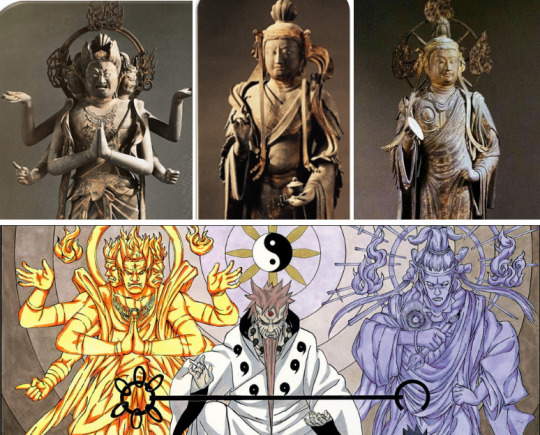
六道rikudou/6 paths of reincarnation, are said to be tendou, ningendou/human, shuradou, chikushoudou/animal, gakidou/hungry spirit, jigokudou/naraka, hell. They live/die/reborn.
外道gedo(in relation to rikudou)/outer path, is outside the circle of reincarnation, such as tengudou, because tengu(former monk died with pride) knows buddhist teachings, can't reincarnate as a human, but is immortal as a tengu so can't continue. 解脱gedasu/moksha, enlightment, is another example.
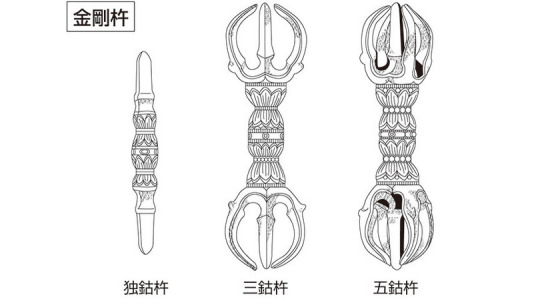
五鈷杵gokusho is type of Kongosho has four prongs pointed to center one. One side said to represent 5 buddhas, 5 wisdoms, while the other 5 greeds to mean indestructible truth of Buddhism. (Butsuma + 4 children adds up to 5?)
A legend says Vajra had multiple prongs pointed outward to showing it's use as a weapon to harm. However, Buddha desires end suffering/harm for all , so he took and pushed prongs inward to turn weapon into an equally powerful tool for self improvement, destroying inner desires, greeds, etc.

In Naruto
Shintou Kami sometimes seen as manifestations of Buddhas/Tenbu(本地垂迹), so I think it fits to see OotsutsukiIndra's Uchiha use Kami(Amaterasu, etc) from creation story as the name of their doujutsu.
Senju's family crest is a vajra with inward prongs, in a sense, a former unstoppable/indestructible weapon of Indra turned into a peaceful staff -> A symbol of OotsutsukiAsura's desire or prophecy to change OotsutsukiIndra.
Hashirama not wearing Senju headband, is kind of like giving up changing Madara. Or changing priorities, gokusho(desires to change OotsutsukiIndra) -> leaf(village protection).

But there's one that does not give up.

#naruto meta#hashirama#madara#madara uchiha#sasuke#sasuke uchiha#naruto uzumaki#uzumaki naruto#senju#uchiha clan#hashirama senju#indra otsutsuki#asura#naruto#meta#manga#anime
231 notes
·
View notes
Note
re: @ Hinduism anon
I'm an Indonesian Buddhist but these days I worship more of the Hindu pantheon. I just wanted to share like, even outside of India the "brand" of Hinduism can change a lot. SEAn Hinduism, dating back to so far as at least 1 BC can be VERY weird (positive) and very interesting, with most precolonial Kingdoms in Indonesia considered as Hindu-Buddhist because of their unique syncretism instead of strictly Buddhist or strictly Hindu.
Even Balinese Hinduism has a very different form and philosophies and they have their own unique branches. The place of worship itself is different (pura instead of mandhir) and there are rituals (like melukat, getting drenched in holy water 10/10 would recommend) and Big Events (e.g. Nyepi Day, Galungan & Kuningan) that don't exist in Indian Hinduism. But I know that some pura are very selective, and I'm aware that it is not my place to just barge in.
So Hinduism, as an old religon is very layered. Yes there are closed aspects of it, like the tantric parts that require diksha (initiation) with the help and guidance of a guru, but not everything. Not once have I ever met animosity when I visited both local mandhirs and pura to worship. The pandit and mangku (Balinese version of pandit) even welcomed me. I think when venturing into a new religion, its important to come with politeness and goodwill, and a willingness to learn.
Thank you so much for sharing this!
This is also along the line of what I learned from the Hindu students I went to college with (brings back some very lovely memories). We didn't have only Indian Hindus. My freshman year roommate was a Sri Lankan Hindu, and a good friend of mine from my freshman dorm floor was a Singaporean Hindu. I think part of what makes Hinduism such a beautiful and colorful religion is how many layers there are to it.
25 notes
·
View notes